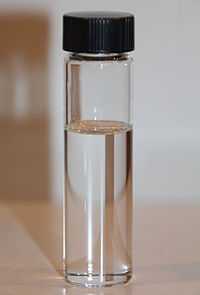
Photo from wikipedia
This article describes the results of multidirectional research on the flammability and heat properties of rigid polyurethane–polyisocyanurate foams (PUR–PIR). They were produced, using new three polyols (citrates) obtained from 2-hydroxypropane-1.2.3-tricarboxylic… Click to show full abstract
This article describes the results of multidirectional research on the flammability and heat properties of rigid polyurethane–polyisocyanurate foams (PUR–PIR). They were produced, using new three polyols (citrates) obtained from 2-hydroxypropane-1.2.3-tricarboxylic acid (citric) and selected diols: propane-1.2-diol (with and without a catalyst) and pentane-1.5-diol (with catalyst). The esterification products enabled the creation of PUR–PIR foams. Their oxygen index and retention were comparable to the non-modified foam. Foam flammability was measured in the new products with the compound. It has been confirmed that the foam modification does not affect its oxygen index, which was about 24%. The retention (residue after burning foams) was in the range of 80–96%. It has been estimated that the addition of citrates shortens the PUR–PIR foam burning time. The addition of 0.1 or 0.3 eq. of the new compounds caused the prolongation of the occurring time for the maximum temperature during burning, from 13 s (reference foam without citrate) to 14 s (foam obtained from citrate synthesized from citric acid and propane-1.2-diol with no catalyst). It also shortened the time to 11 s (foam with citrate synthesized with propane-1.2-diol, using catalyst) and to 10 s (foam included citrate obtained from citric acid and pentane-1.5-diol, with catalyst). The ratio of HRRmax value to the time in which it was reached is in the range of 9.14–11.75 k W/m2 s. There was no observable correlation between the oxygen index (OI) and the amount of citrate in the foam. After the modification of PUR–PIR foam with citrate compounds, similar IO values can be observed in the range of 23.8–24.0% (for reference foam was 23.9%).
Journal Title: Polymer Bulletin
Year Published: 2017
Link to full text (if available)
Share on Social Media: Sign Up to like & get
recommendations!